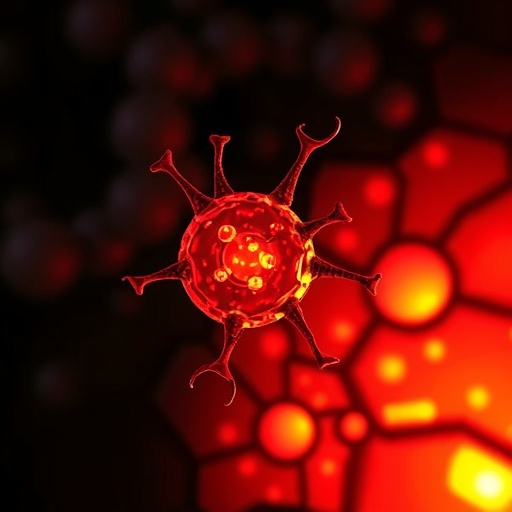In a groundbreaking study recently published in Nature Communications, a team of researchers led by Zhuang, Zhang, and colleagues unveils a pivotal mechanism by which cells regulate their energy metabolism under conditions of thermal stress. Central to their discovery is the role of chaperone-mediated autophagy (CMA), a selective degradative pathway, in stabilizing the energy metabolism master regulator PGC1α. This finding not only expands our understanding of cellular stress responses but also opens new avenues for therapeutic strategies targeting metabolic disorders and age-associated diseases.
Cells are constantly challenged by fluctuations in their environment, with temperature shifts representing among the most severe stressors. Thermal stress can disrupt protein folding and damage cellular components, necessitating robust quality control and adaptive mechanisms to maintain homeostasis. The study meticulously dissects the crosstalk between CMA and mitochondrial function, with particular emphasis on how this interaction preserves cellular energy balance during and after episodes of elevated temperature.
PGC1α, the peroxisome proliferator-activated receptor gamma coactivator 1-alpha, functions as a master regulator orchestrating mitochondrial biogenesis and energy metabolism. Its activity is normally tightly regulated at multiple levels including transcription, post-translational modifications, and protein turnover. The research reveals that under thermal stress, CMA selectively targets specific proteins to modulate the stability and activity of PGC1α, ensuring the cell’s metabolic machinery adapts swiftly to environmental challenges.
The authors utilized a combination of molecular biology, imaging, and metabolic flux analyses to demonstrate that CMA promotes the selective degradation of inhibitory factors that otherwise destabilize PGC1α. This selective autophagic process thus indirectly enhances PGC1α stability, allowing the activation of downstream transcriptional programs that boost mitochondrial function and energy production. Such an adaptive response equips the cell with increased resilience against thermal perturbation.
Intriguingly, the study also shows that suppression of CMA activity, either genetically or pharmacologically, leads to significant metabolic dysfunction when cells are exposed to heat stress. This finding underscores the essential nature of CMA in maintaining energy homeostasis under adverse conditions. Cells deficient in CMA displayed reduced mitochondrial content, decreased ATP production, and impaired recovery from metabolic stress, highlighting the pathway’s protective role.
Beyond fundamental cell biology, this research has profound implications for understanding how organisms manage metabolic challenges in fluctuating environments. Thermal stress is common not only in pathological contexts such as fever but also in occupational and environmental exposures. Unraveling the mechanism by which CMA regulates PGC1α stability enriches our grasp of cellular flexibility and survival mechanisms, potentially informing treatments for diseases linked with mitochondrial dysfunction, including neurodegenerative diseases and metabolic syndromes.
The intricate regulation of protein quality control pathways like CMA is a testament to the cell’s evolutionary ingenuity. Unlike bulk autophagy, CMA selectively recognizes specific protein substrates containing KFERQ-like motifs, directing them for lysosomal degradation. This selectivity allows precise control of key regulatory proteins such as PGC1α, ensuring timely and context-dependent metabolic adjustments. By focusing on CMA’s role in thermal stress, this study adds a new dimension to our understanding of autophagic regulation of metabolism.
Technically, the researchers employed state-of-the-art proteomics to identify CMA substrates and used live-cell imaging to monitor mitochondrial dynamics in real time. Results indicated that heat-induced activation of CMA is a finely-tuned process that balances protein clearance with metabolic demand. Notably, they observed heightened CMA activity correlating with increased mitochondrial biogenesis, a response that mitigates the deleterious effects of thermal damage on energy production.
The researchers also dissected the signaling cascades upstream of CMA activation during thermal stress, elucidating involvement of pathways that sense protein misfolding and oxidative stress. These signaling networks coordinate CMA induction, linking environmental cues to cellular metabolic adaptations. Furthermore, the study explored how modulation of CMA influences reactive oxygen species (ROS) levels, which are critical indicators of mitochondrial health and stress status.
Such insights provide a molecular framework explaining how CMA serves as a linchpin integrating proteostasis and metabolic regulation. The study’s data show that by stabilizing PGC1α, CMA indirectly supports the transcriptional activation of genes involved in oxidative phosphorylation, fatty acid oxidation, and antioxidant defense. Consequently, the cell enhances its capacity to generate ATP efficiently while minimizing oxidative damage, an essential balance for survival under thermal stress.
This investigation also touches upon the potential connection between CMA dysregulation and age-related decline in mitochondrial function. Given that CMA efficiency diminishes with age, impaired PGC1α stability might underlie some metabolic deficits observed in elderly tissues. The authors propose that therapeutic enhancement of CMA could rejuvenate metabolic flexibility and protect against diseases characterized by mitochondrial decay.
In exploring therapeutic potential, the authors speculate on pharmacological agents capable of modulating CMA activity. Such compounds could provide targeted intervention avenues to restore mitochondrial health, not only under stress conditions but also in chronic metabolic diseases. However, they caution that precise tuning of CMA is required, as unregulated autophagy might trigger undesired degradation of vital proteins.
The study’s comprehensive approach also included in vivo models demonstrating that organisms with enhanced CMA activity show superior thermal tolerance and metabolic adaptation. This reinforces the translational relevance of the findings and inspires future research in physiological and clinical contexts including fever response, heat stroke, and metabolic syndrome.
Collectively, this research presents a paradigm shift in our understanding of cellular adaptation to thermal stress, positioning chaperone-mediated autophagy as a critical guardian of energy metabolism through the stabilization of PGC1α. The findings illuminate intricate layers of metabolic regulation and underscore the potential of targeting CMA to mitigate metabolic and stress-related diseases.
As the scientific community delves deeper into the intersections of autophagy, proteostasis, and metabolism, studies such as this pave the way toward innovative therapeutic strategies. By revealing the nuanced role CMA plays in modulating cellular energy homeostasis, Zhuang and colleagues contribute a vital piece to the complex puzzle of how cells endure and thrive amid environmental adversities.
The implications of these findings extend beyond heat stress, inviting investigation into CMA’s role in other forms of cellular insults such as hypoxia, nutrient deprivation, and oxidative damage. Future research building on this foundation promises to unveil novel mechanisms of cellular resilience and inform diverse biomedical applications.
Ultimately, this study not only challenges existing dogma but also invigorates the field of metabolic research with fresh insights into the dynamic regulation of mitochondrial function. It serves as a sterling example of how the interplay between selective autophagy and metabolic control is essential to cellular survival and function in a fluctuating environment.
Subject of Research: Chaperone-mediated autophagy regulation of PGC1α stability and energy metabolism under thermal stress.
Article Title: Chaperone-mediated autophagy manipulates PGC1α stability and governs energy metabolism under thermal stress.
Article References:
Zhuang, Y., Zhang, X., Zhang, S. et al. Chaperone-mediated autophagy manipulates PGC1α stability and governs energy metabolism under thermal stress. Nat Commun 16, 4455 (2025). https://doi.org/10.1038/s41467-025-59618-0
Image Credits: AI Generated
Tags: age-associated diseases researchcellular stress responseschaperone-mediated autophagycrosstalk between CMA and mitochondriaenergy metabolism under thermal stressheat-induced cellular responsesmaintaining cellular homeostasismitochondrial function and energy balancePGC1α regulation mechanismsprotein folding and quality controlselective degradative pathwaystherapeutic strategies for metabolic disorders





